
JS:
I've heard of zha jiang mian spoken of quite fondly: it is even considered by its eaters as one iconic dish, evoking the same warm, fuzzy feelings that "spaghetti" does for most people.
Wikipedia: http://en.wikipedia.org/wiki/Zha_jiang_mian
For some reason, the vagaries of our lives never permitted our stomachs and zha jiang mian to cross. I'm racking my brain if I've ever had this dish at home and I'm coming up blank.
No, no, no. . . we didn't have a "Chinese Spaghetti" in our childhoods: we just had the regular ol' spaghetti. Okay, not so regular, because our version is somewhat different from spaghetti bolognese. We had ours with hotdogs -- but hey, that's another story for another day.
When I saw the Jessica's version of zha jiang mian on FoodMayhem, I thought it was time to give this Chinese spaghetti a try.
TS:
Literally translated, zha jiang mian means "fried sauce noodles". In this case, the sauces are composed of various "bean" sauces.
Here are the three we used. If making this dish, my advice would be to copy down the Chinese names (or print them out), as most of the time, all of these products would be vaguely labeled as "bean paste" in English. Very confusing indeed.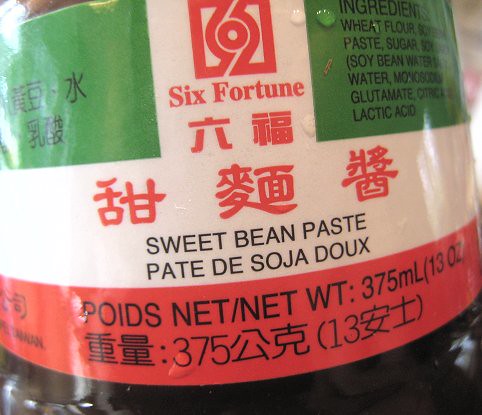
甜麵醬, translated this time as "Sweet Bean Paste"
豆瓣酱, translated this time as "Soy Bean Paste"
京都炸醬, translated as "Mandarin Jah-Jan Sauce"
TS:
I happened to find that jar of "Mandarin Jah-Jan Sauce" lying around. And hey, if it says that it is the sauce for Northern-style "Zha Jiang", then I definitely should throw it into the mix!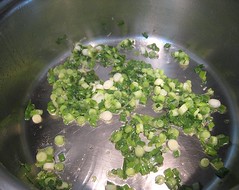
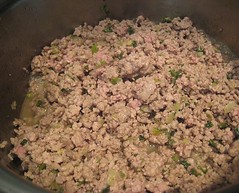


TS:
This is quite easy to make, even easier and faster than spaghetti sauce.
I cooked some green onions in oil, then added ground pork. After cooking the meat for a bit, the bean sauces and some water go in. Everything cooks for a bit more. I added a touch of sesame oil near the end for extra fragrance.
TS:
We didn't have any Chinese noodles in the house, so we used fettuccine.
This dish is usually served with raw cucumbers, so I made little cucumber curls. . . just for one bowl. For the blog! ;)
TS:
Of course, we didn't bother with the fancy plating for ourselves. We simply tossed the meat sauce with the noodles and served the dish family-style.
(And yes, I know that, once again, that below is a huge amount.)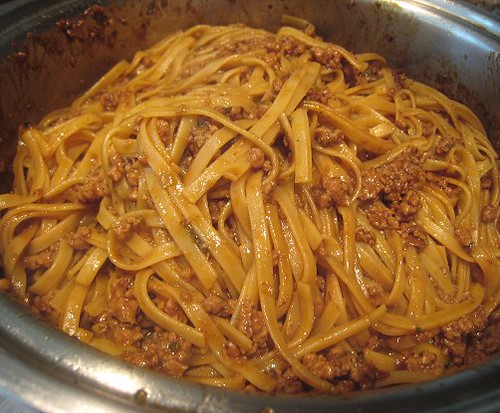
big pot o' Chinese spaghetti
JS:
This was quite popular with the family.
The meat sauce was hearty, deeply and darkly savoury, but with enough of sweetness to balance it off.
In fact, I think this zha jiang mian was even more popular with some family members than what I have been calling in our house as the Chinese equivalent to ragu bolognese, namely, the Taiwanese Stewed Minced Pork sauce (魯肉飯 or 肉燥飯).
Our recipe for Taiwanese Stewed Minced Pork sauce (魯肉飯 or 肉燥飯)
Me? I'm quite undecided which Chinese "bolognese" I prefer. Following Solomon's infinite wisdom for my end of infinite gluttony, I suppose I would have to split my stomach into two.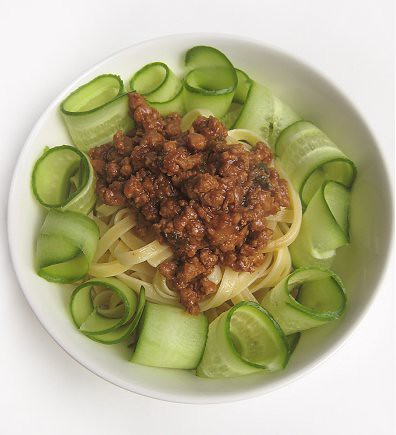
Enjoyed this post? Why not subscribe to our blog? Subscribe via reader or subscribe via email. Thank you! |
Recipe
Zha Jiang Mian, aka "Chinese Spaghetti" (炸醬麵)
adapted from FoodMayhem's version: http://www.foodmayhem.com/2009/11/za-jiang-mein.html
This is quite a large amount, as we used 2 pounds of pasta. Please feel free to halve the recipe.
900 g (2 pounds) fettuccine, or Chinese wheat noodles
2 tablespoon vegetable oil
6 stalks green onion, chopped
3 pounds ground pork
1/2 cup sweet bean sauce/paste (甜麵醬)
1/3 cup soy bean sauce/paste (豆瓣酱)
1/3 cup Mandarin Jah-Jan sauce/paste (京都炸醬)
2/3 to 3/4 cup water
1 tablespoon sesame oil
julienned raw cucumbers
Boil water for your noodles. When boiling, add your noodles and cook according to package directions.
For the sauce, heat oil in a pot over medium heat. Cook green onions until soft and fragrant.
Add the ground pork and when it is almost fully cooked through, add the three bean sauces and water. Stir occasionally and let cook, uncovered, until the mixture has thickened. Add sesame oil, and adjust seasoning (salt or sugar), if needed.
Serve over cooked noodles. Or, toss noodles and sauce together. Serve with julienned raw cucumbers, if desired.






Now I need to go to 99 Ranch to get me those 3 sauces. I love the looks of this & so easy to make. (Can I add hotdogs? LOL just kidding) :)
ReplyDeleteAn interesting change from the regular tomato & meat sauce
ReplyDeleteI love both Korean and Chinese zha jiang mian! So tasty!
ReplyDeleteCaroline:
ReplyDeleteWell, maybe Chinese sausages can be the "hotdogs". ;)
pigpigscorner:
I haven't tried the Korean version. Will do when I get the chance.
First of all thank you for your recipe. However, I do think there is no need to use Jingdu ZhaJiang 京都炸醬. This zhajiang is already a ready made zha jiang for zha jiang mian. One can use this zha jiang directly on pork & vegetables without any tianmian jiang and others.
ReplyDeleteA friend from Xian said it is rather traditional in Xian to add tomatoes as in fresh tomatoes and carrots to the sauce - carrots could be diced or julienne. In Beijing, they add tomato sauce fanqie jiang 番茄醬. LOL!
Apparently, zha jiang mian suppose to be salty and sweet. I leave out the salty and add a little honey instead of sugar.
Thanks for sharing the recipe again and I hope you find my comments helpful.
Thanks for the comment! We really do need all the help we can get with all these different types of bean pastes!
Delete